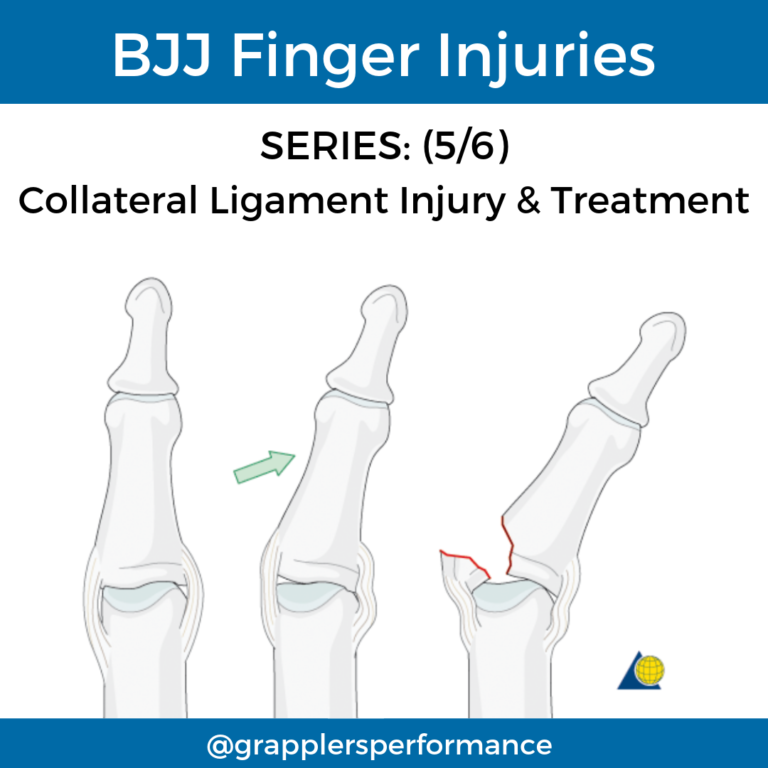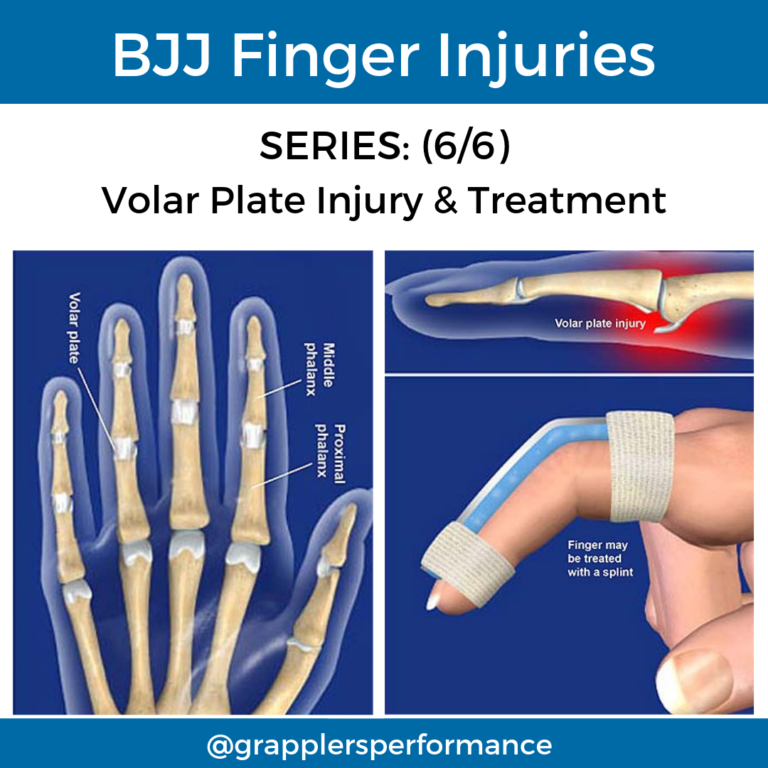Common BJJ Finger Injuries: Part 2
What’s the actual finger injury? Whats their common symptoms? How does the research say to best manage them? All of this we will go over in Part 2 of our series on Common BJJ Finger injuries.
Missed Part 1? We go over finger anatomy and give a brief introduction to common BJJ finger injuries. Check it out HERE.
Each finger injury is different. You may have more than one injury type on the same finger. Use this post as a general guideline to better inform yourself. However, with lingering or more severe finger injuries, it is always useful to get it looked at to rule out fractures and other bony injuries that take longer to heal.

Mallet Finger – Common BJJ Finger Injury #1
Mallet finger is the most common closed tendon injury of the finger. Typically it occurs due to injury of the extensor tendon at the DIP joint.
The results from forceful bending of the DIP joint when straight, causes the tendon to over stretch, partially tear, completely rupture or separate via avulsion fracture. Bony avulsion fractures occur 33% of mallet finger injuries.
Common symptoms typically include pain at dorsal DIP joint, inability to actively extend DIP, and flexion deformity.
The treatment? First get a radiograph to clear a bony injury. If no avulsion fracture is present:
- Splint the DIP in neutral or slight hyper-extension for 6 weeks.
- The splinting period must restart every time flexion occurs.
- You can continue to participate in training if splinted.
- At 6 weeks, If active DIP extension is present, splinting can be limited to sleeping and activity for 6 more weeks.
- Conservative management is useful for up to 3 months.
The finger can become deformed if the injury is left untreated.
Some good things to know about Mallet finger is that clinical examination alone cannot diagnose fractures. Radiography views for finger injuries should include oblique, anteroposterior and true lateral. True lateral radiography is the most effective way to examine anatomic joint congruity. However, Ultrasonography is emerging as an effective tool to evaluate soft tissue structures.
Jersey Finger – Common BJJ Finger Injury #2
Jersey finger is the disruption of Flexor Digitorum Profundus tendon. It commonly occurs when your finger gets caught during training and/or competition.The injury causes forced extension of the tip of the finger joint (DIP) during active flexion. The ring finger is the weakest finger and accounts for 75% of jersey finger cases. The injury can occur if the force is concentrated at the middle phalanx or at the distal phalanx.
Common symptoms can include pain, swelling at the top of the knuckle.

Do you have Jersey finger? Isolate the affected DIP joint by holding the PIP and MIP joints and attempt to flex the DIP joint. If the Digitorum Profundus tendon is damaged, the joint will not move. The Flexor Digitorum Superficialis tendon should be evaluated by holding the unaffected fingers in extension and asking the patient to flex the injured finger. An injured Flexor Digitorum Superficialis tendon will produce no movement.
The prognosis for patients with Jersey Finger worsens if treatment is delayed and/or if severe tendon retraction is present.
Patients with confirmed or suspected jersey finger should be immediately splinted. Once splinted, patients should be referred to an orthopedic or hand surgeon for treatment.

Boutonniere Finger – Common BJJ Finger Injury #3
A tear of the Central Slip Extensor Tendon commonly occurs when the PIP joint is forcibly flexed while actively extended. The PIP joint should be evaluated by holding the joint in a position of 15 to 30 degrees of flexion. If the PIP joint is injured, the patient will be unable to actively extend the joint; however, passive extension should be possible.Tenderness over the dorsal aspect of the middle phalanx will be present. A delay in proper treatment may cause a fixed boutonnière deformity.
To treat, The PIP joint should be splinted in full extension for 6 weeks. All available splints can be used to treat PIP injuries, except for the stack splint, which is used only for DIP injuries. As with mallet finger, extension of the PIP joint must be maintained continuously. If splinted, continued training and competition participation is allowed.
Splinting duration is the same as with Mallet finger (above).
Collateral Ligament Injuries – Common BJJ Finger Injury #4
Forced ulnar or radial deviation at any of the interphalangeal joints can cause partial or complete collateral ligament tears.The PIP joint usually is involved in collateral ligament injuries, which are commonly classified as “jammed fingers.” Collateral ligament injuries present as pain located only at the affected ligament.
The injury should be evaluated by applying valgus or varus stress to the involved joint in 30 degrees of flexion while the MCP joint is flexed at 90 degrees.X-Ray may demonstrate an avulsion fracture at the ligamentous insertion point.
To treat, if the joints are stable and no large fracture fragments are present, the injury can be treated with buddy taping (i.e., taping the injured finger, above and below the joint, to an adjacent finger).


If the ring finger is involved, it should be secured to the fifth digit, because the fifth digit is naturally extended and easily injured if exposed.
Patients with collateral ligament injuries may continue participating in athletic events as symptoms allow.
Volar Plate Injury – Common BJJ Finger Injury #5
Hyperextension of a finger joint, such as a dorsal dislocation, can injure the volar plate. The PIP joint usually is affected, and collateral ligament damage often is present. The volar plate can be partially or completely torn, with or without an avulsion fracture. The subsequent loss of joint stability may allow the extensor tendon to gradually pull the joint into hyperextension, causing deformity.
Maximal tenderness will be located at the volar aspect of the affected joint. Full extension and flexion will be possible if the joint is stable. The collateral ligaments should be tested as with collateral ligament injuries. Radiographs may show an avulsion fragment at the base of the involved phalanx.

To treat a volar plate injury a stable joint without a large avulsion fragment should be splinted with a progressive extension splint (“block splint”), starting at 30 degrees of flexion for two to four weeks, depending on injury severity; buddy taping should follow. Increasing the extension of a dorsal aluminum splint weekly will progressively increase range of motion. In less severe injuries, the injured joint should be buddy taped. This will restrict some extension and provide support.
These two techniques may allow a patient to continue participating in athletic events sooner; however, participation depends on the athlete’s sport and position; it is difficult to play some sports with a flexed PIP joint.
Referral criteria include an unstable joint or a large avulsion fragment.
Leggit and Meko, 2006. Acute Finger Injuries: Part 1. Tendons and Ligaments. Am Fam Physician. 2006 Mar 1;73(5):810-816.

